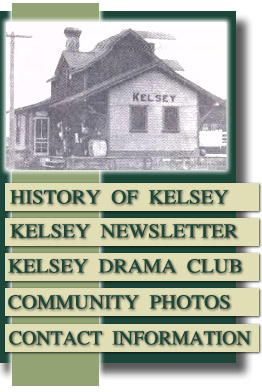
Celebrating Kelsey
by Don Gregorwich
On July 23, 2005 a large crowd of Kelsey Community residents gathered at the Camrose Railway
Station and Park to celebrate the contributions of some early pioneers to the Kelsey area and surrounding communities.
While many of those in attendance were residents of the Kelsey community,
a large number were folks who traveled from near and far to take part in the activities.
This celebration was due to the efforts of the Railroad Museum administrators, Glenys and Bruce Smith
along with their staff members. Glenys and Bruce have successfully initiated a program through which the Museum
recognizes the important contributions of our early settlers ino the development of our society as it exists today
in Camrose and its surrounding towns, villages and communities.
We need to give them a great deal of credit for their tireless efforts in helping all of us begin to appreciate
the hardships, successes and backgrounds of those early pioneers who settled this land a century ago.

To Glenys and Bruce, from the community of Kelsey, a heartfelt �thank you�!

The Program
The afternoon actually started about 11:30 am with a lunch served in the Railway Station Tearoom.
The menu consisted of foods which would have been prevalent in the areas of the USA where many of the early
settlers came from.
During the previous week, Glenys and her staff put together displays of early pioneer artifacts on loan to the Museum
by many of the area residents. The items, which were on display in the Railway Station, helped to encourage reminiscing
by more senior visitors and were admired by younger folks.
As well, Jeppa Danielson and his remarkable train gave rides to children of all ages during the afternoon.
Between 2:30 and 4pm the audience, seated in chairs on the station platform, listened to the stories of three
pioneer families from the Kelsey community. Edna Nelson gave the story of the Zimmerman family,
Vida Innes told of her family, the Herman Berke family. Greg Thirsk told the Moses Kelsey story in the form of a monologue.
Our Very Special Guests
Perhaps the most special part of this event was that two Moses Kelsey relatives attended.
Joy Bruce is a great granddaughter of Moses brother Albert while Lorraine Wingard is a great granddaughter
of Moses brother Almond. Albert and Almond were twin brothers.
Joy lives in Oklahoma and Lorraine is from Montana. It was our pleasure to meet these two charming ladies and they
certainly helped to provide a special touch to these celebrations.
What a commitment they made to travel to take part in this weekend !
Edna Nelson gave Joy and Lorraine a �historical� tour of the Kelsey area on Sunday, July 24.
In Conclusion
There really is no conclusion to this story. Kelsey started a century ago and while it has changed dramatically
over the decades, the community still remains strong and vibrant and productive. It is to be remembered that a
community really has no boundaries and is composed of people and not necessarily just of buildings crafted by man.
�Celebrating Kelsey� is just one more wonderful event in the life of this community!

Community Connections
by Glenys Smith
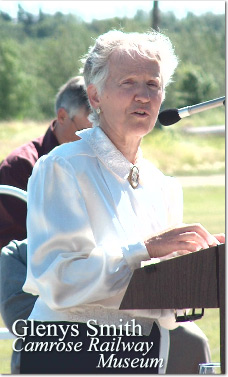
The Tribute to Kelsey display is indicative of how communities connect in an interdependent way to make a community a living, vibrant place to live. The community of Kelsey was like many other communities in Alberta. The pioneers came full of �hope.� They came to fulfill a dream to have land of their own that was productive, that would sustain them and their families.
As the settlers slowly arrived they learned to build a community of caring, helpful people. They depended on one another not just for survival, but also for the greater spiritual needs of fellowship and culture. The many faces of community connection can be seen in the displays; The systems that brought the settlers, the roots of the community (i.e., The pioneers who first settled the land), the farming establishment and the services that served the people thus the growing of the Hamlet, the connections within the community (i.e. Neighbors visiting neighbors for entertainment, the church, the school and the General store), the generational connections where people were born, grew up, married, raised families and where they passed on.
Kelsey was always a small Hamlet, but a place where people lived their lives sharing their talents and gifts in community. They contributed in many ways to make it a better place. We salute the people who not only were pioneers of this community, but who have moved on and whose ancestors continue to contribute to our society as the legacy of positive family values were passed on.

INTERPRETIVE MONOLOGUE REPRESENTING THE 1902 HOMESTEAD FLOOD INTO THE AREA EAST OF DRIED MEAT LAKE (KELSEY AREA)
as presented by Greg Thirsk, Kelsey, July 23, 2005
CHARACTER: MOSES KELSEY
SETTING: 1902 and the early years; homesteading in the Kelsey area
ABSTRACT: Moses Kelsey arrived with his wife Martha, son Earl and daughter Minnie from South Dakota in spring of 1902. After landing at Wetaskiwin, they faced a 2 day journey plagued with hardship due to �monsoon rains� as they traveled to their new homestead that the present town of Kelsey is now situated on. Once there, they set to work building a homestead and a life on land that had been well-prepared by prairie fires in the previous decade. A house was built, and crops of hays and wheat were harvested. The neighbors from miles around would gather at Ferry Point for Friday night dances and July 1st picnics. Earl Kelsey had a friendship with a schoolteacher but never married. He went on to patent a Flying Machine invention. Minnie lost her first husband in the flu epidemic and remarried a man with children who had also lost his wife. After their father died, Earl stayed on farming and took care of his mother Martha. They had some hard times during the Great Depression and were always quite poor (as were most in the area). The town of Kelsey was named after Moses Kelsey, who was the first to �break the prairie sod� on its present site.

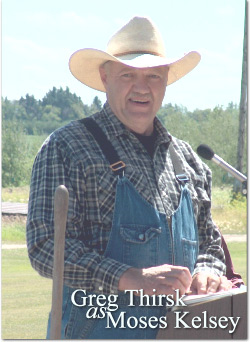
I arrived from South Dakota in 1902 with my wife and family, hungry for fertile parklands and good farming. Our landing point was the new siding at Wetaskiwin, but the most challenging part of our journey still lay in the 2 days ahead. What a trip that was! After unloading our car of settlers� necessities, we turned our attention to the 60 mile trek ahead. Our destination lay in the rich parklands east of Dried Meat Lake. And let me tell you, the weather was not on our side! Back home we were living in a drought and we arrived here to find a monsoon! The rains had come with a vengeance that spring, the creeks overflowed with water, and the lowlands were flooded. Oh, those muddy trails plagued us, not to mention wet supplies, leaky tents and swarms of mosquitos! I�ll never forget that steep descent into the valley of Pipestone Creek. My wife Martha was frightened half to death, and I was too, though of course would never let on to her. We rough-locked a wheel with a length of chain to give us some sort of brake, and the oxen worked hard with a bit of fear in their eyes as we descended that steep muddy hill. But you could always count on a good neighbor willing to lend a helping hand in those days. A team of horses was waiting at the top of the hill to help us up that slippery devil of a slope. That night we stopped at the MacDonalds at Heather Brae to rest the horses and get a good meal. We were charged 20 cents for meals, 20 cents for a bed and 25 cents for a team of horses. We heard stories at the MacDonalds of homesteaders becoming so mired in one bottomless mud-hole that the drivers had to unhitch the team, unload the wagon, dismantle it and haul it piece by piece to higher ground. There was many a time that a homesteader would ingenuously overcome muddy roads by lashing the lumber for their buildings onto rafts and floating their possessions down the swollen river!
That year we arrived with a �homestead flood�, and the federal land locator was taking prospective homesteaders east of Dried Meat Lake to make their homestead claims. When I first laid eyes on my homestead, well, I just knew. The richness of the land! Now there was a fellow by the name of Johnny Burke who was one of the first men to see this part of the world back in 1893. He decided to make this his home and became real friendly with the Indians, visiting and learning their language. Boy the stories he had. He claims that more than once he hid behind the skirts of an old Indian woman when some rebel braves rode into camp during the Riel Rebellion. But Johnny Burke�s stories of the weather and the prairie fires back in the 1890�s really stole the show! He said there were some painful dry years that parched the earth. Horses were known to break their legs in the great cracks. Dried Meat Lake went bone dry and there were some who even put up hay for their horses in the lake bed. With the buffalo gone, the prairie grasses grew thick and matted and with the droughts the entire landscape was a tinder box waiting to ignite. Prairie fires swept with the wind in a rage! I couldn�t believe my ears upon hearing a report of a single fire sweeping for a hundred miles! So you can see how my new homestead was a site for sore eyes. Miles of cleared land with few big trees, and the sapling growth could still be plowed under with horses on a breaking plow.
We made ourselves a home in this new land. Some of our neighbors built their first homes from the earth itself. Those �Soddies� were sure known for being warm in the winter and cool in the summer. Others built a home of poplar logs from groves that had escaped those prairie fires. My wife Martha was adamant about having a shiplap floor since she said plain dirt floors should only be found in a bachelor�s home.
Those first few years blessed us with plentiful rain and we grew bumper crops of hay with almost no effort. But to break the land for grain production, well that was another story. In those days, a man�s horses and milk cow spelled the difference between success and disaster for his family. Horses not only enabled us to go on supply trips or to social gatherings, they tilled the fields and reaped the harvests of grain and hay. There was many a wife who believed that her husband treated his horse better than her! Since horses were usually scarce and expensive, though, some settlers had to turn to ox or mule power. Oxen were painfully slow, but you had to be careful not to trigger their temper. Stories would go around our supper table for years about so-and-so ending up head first in a bush or slough after a headstrong oxen team had had enough of the heat, flies, and driver! It was a big event in 1905 when Ludwig Peterson brought out the first steam engine from Dried Meat Lake to thresh in the area.
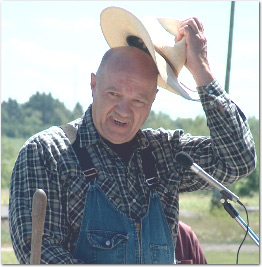
Homesteading was real hard work, but we found our ways to have fun too. A trip into Ferry Point settlement was always eventful. Ferry Point was a general store and trading post combined, sitting right on the bank of the Battle River not too far south of my homestead. It was a busy place some days, buzzing with Half-breed trappers, new settlers, and cowboys from nearby ranches.
Friday nights at Ferry Point�.. those were good old times! Settlers from probably 20 miles around would gather up their neighbors on Friday night and head for the Ferry Point hall. The hall would reverberate with the sounds of the fiddle and the organ. Dancers would whirl around the floor, and the caller sure had to raise his voice to call out those square dance steps. The coffee pot was always on and �ladies brought lunch�. Box socials were sometimes added to the supper and it was always a bit of fun to see those young men vying to share a special ladies supper.
The July 1st picnic, now that was the highlight of the summer�.that picnic went on for as long as I can remember! I�ll never forget that Ludwig Peterson steaming down from Dried Meat Lake with his paddle wheeler and offering river cruises to one and all. Competition heated up when the ball games were about to begin, and if I can recall there was an inconspicuous booth set up back with Fred Baird serving up a bit of beer. The children ran wild with the fun of it all�..races were raced and games were played. An ice cream cone was often the coveted prize for winning! Those were the days!
My son, Earl, met a pretty young schoolteacher at one of these gatherings. He was smitten with her, but the friendship never lasted. I don�t know the story between them, but Earl was destined to remain a bachelor for the rest of his days. Some speculated that perhaps he was too busy working on his Flying Machine but somehow I don�t think that was the case. But he sure did put a lot of work into his invention, yes my boy was a smart one he was. Earl had drawings and diagrams of that flying machine all over the house. You see, in those days people flying those contraptions were exposed to wind, cold, and weather. Earl�s invention had a sort of housing on it that enclosed the operators, a dome if you will that was lightweight and provided very slight resistance to the air. My son even got his Flying Machine patented in 1912 by the United States Patent Office.
Martha and I also had a daughter who we adopted back in South Dakota. Minnie was a godsend and helped Martha a great deal with all of the hard work that falls to a settler�s wife. Our Minnie fell on hard times after she married, though. With two children under her wing, she lost her husband in the flu epidemic. In 1921, she remarried a man named George Hall who had also recently lost his wife and was left with 3 daughters to care for. Well, I suppose all those children needed a mother and father under the same roof, and I�m glad our Minnie found someone to help provide for my grandkids, especially with the Dirty Thirties right around the corner. Those were some grim times. It was just Earl and Martha left to take care of the farm by then. Everyone was real poor and the wheat crops took a beating. 1931 represented the fourth year in a row that the crop hardly paid for itself. Earl turned to raising pigs as well, but prices were low and there was a lot of worry and discouragement in many a settler�s household. When Martha died, Earl sold the farm and moved to the bustling city of Edmonton where he would spend the rest of his days.
You know, the town of Kelsey was named after yours truly. It sure is an honor and it�s all because of my good old neighbor Milton Zimmerman. He arrived in the same year as I did, 1902, and it was he who suggested that the new town of Kelsey be named for the man who had first broken the prairie sod on which it stood. Yes, it sure is an honor to leave a legacy after one passes from this world.

The Kelsey Family in America
by Joy Kelsey Bruce
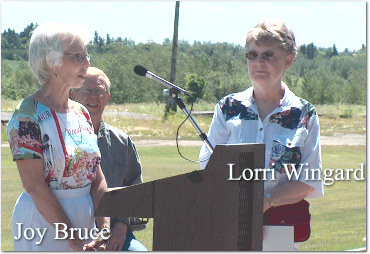
The first Kelsey in America was William Kelsey. He was born in England in 1620 to George Kelsey Jr. and Elizabeth Hammond Kelsey.
One of the original �Braintree Company� group who were followers of Reverend Thomas Hooker, he settled in New Town, (now Cambridge) Massachusetts, in 1633. Some 50 members of the church moved to Connecticut and established a second New Towne, with the name being changed to Hartford in 1637. William�s name remains on various monuments and documents in that area.
William�s son, Stephen was born in 1647 and died in 1719. He married Hannah Ingersoll.
Stephen and Hannah�s son, Stephen Jr. married Dorothy Bronson.
Their son, named Ebenezer married Hannah Hubbard. They are recorded as joining the Congregational Church in Sandisfield, Connecticut in 1769.
Their son, also named Ebenezer, was born in 1755 and died in 1815 in New York State.
Ebenezer�s son, Daniel seems to be the same Daniel that was our ancestor. He was born in New York in 1797 and died in Northfield, Minnesota in 1966. He married Mary Carpenter and they migrated to Michigan area before 1850.
Moses was born in Spring Arbor, Michigan, which is located in Jackson County, in 1847. He was the seventh of eight children. By 1860 the family had relocated to Dodge County, Minnesota. Moses, along with brothers Ebenezer, Stephen and Aaron and sister, Mary made the move with their parents while brothers Daniel, and the twins, Albert and Almond, stayed behind.
Moses later moved to Dakota Territory, before homesteading in Canadian 1902.
Twins, Albert Wildey Kelsey and Almond Wilbur Kelsey went separate ways, both serving in the War Between the States. Albert bought land in Pettis County, Missouri and lived there his entire life. Almond lived for a time in Minnesota and South Dakota before joining a wagon train across Montana and settling in Idaho, where he died.
In the 1980�s, Lorraine Wingard, great granddaughter of Almond was living in Montana, and I, Joy Kelsey Bruce, great granddaughter of Albert, lived in Oklahoma. We were both involved in researching the Kelsey family, and as so often happens, we cousins found each other. We have corresponded since that time, and especially after the marvel of e-mail came along. We are anticipating, if plans work out, to meet for the first time and attend the Moses and Earl Kelsey Tribute this July in Camrose.

(Excerpts from As The Wheels Turn, 1982)
Those Kelsey Flyers
by Mearl Zimmerman, As The Wheels Turn
This has to go back to World War II days for the beginning. Air Force training put out a few locals as pilots.
Probably the next phase was shortly after the war, when Dave Harrington came out of Edmonton with an old Tiger Moth two-place (carried two people, including the pilot) biplane and gave rides on Sundays from Hobart Zimmerman�s field. In 1949 Cliff Gallant learned to fly and brought home a new 100 M.P.H. 90 h.p. five gallon an hour, two-place Luscombe, and all for $6,000. He flew this off of the farm fields, and it furnished the first airplane ride for many local residents.
Some years later Jim McDonald got his license at Wetaskiwin, and brought home a Piper PA-11, a two place tandem seating, where one sits in front of the other. With 90 h.p. and quite light, it was about the best performing airplane ever built� a habit of that PA-11 was sneaking up on some poor, helpless tractor operator- from behind. No tractor cabs in those days, and it would give one quite a start, the instant roar of the motor and propeller, and the sudden form of the aircraft over- very close, at 100 miles per hour. Many tractor operators had a 15-minute break as it would land right there and take them for a ride.

George William Nelson
George was interested in radio. He built himself a radio transmitter using a barbwire fence and headphones for starters. When he was experimenting with this, his sisters Helen and Margaret were elected to help him. He sent them down the fence line a half-mile to see if they could hear him talking on the other end, and they were always running back and forth to let him know how they were receiving him. When he got this perfected he got some more equipment and started broadcasting from his farm. You could hear him on radio only on weekend. On Saturday nights he played records, and on Sunday he had anyone who could sing or play perform for his radio audience. Quite a few people took part in this, and if no one showed up he would then play records again. He had a good receiving audience, and people waited for the weekend to hear him. He had his radio station for about a year, but was shut down because he never had a license.

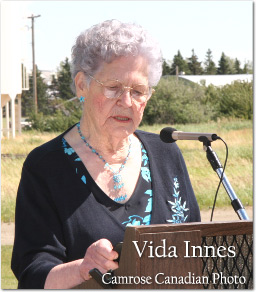
Presentation: Vida (Berke) Innes
My name is Vida (Berke) Innes. I am the second daughter of Herman and Myrtle Berke born in 1920. That is just 20 years after the early pioneers homesteaded in this area.
Herman Berke came to the United States at the age of two from Nanstead, Norway with his parents, settling in Bradley, South Dakota.
In 1900, Herman came to Calgary where he worked as a �roofer� at Eau Claire Lumber. The he came by train to Wetaskiwin, which was at that time the end of the railroad.
He set out from Wetaskiwin on foot looking for land for a homestead, heading east to Flagstaff, but he didn�t like the rolling land and sandy soil for farmland. He then went on towards Ferry Point going north to the area that later became �Kelsey�. At the turn of the century, on April 19, 19o1 he filed on his homestead N.E. 4-45-18. The �Spring Lake Trail� ran through the N.E. corner of Berke�s pasture quarter and the track was still evident in 1958 when the land was first brushed and broke.
The trail was the main route from Spring Lake to Wetaskiwin and was used by everyone going to town for supplies. The route was very crooked and kept to higher ground. The track was cut through the sod as it was worn deep from Constant use. It was said the trail �split like a chicken foot.�
Herman�s was one of the �stopping off� places on the route as people traveled on through- en route to Wetaskiwin to purchase supplies.
Bawlf was the nearest town after 1904 so it then became the address. On Herman�s homestead, there was a log building with a sod rook. This was likely used for squatters or Natives.
Herman later lived west of Kelsey- what was called the Phipps Place. Picture shows he had pigs, chickens, and livestock. He was married to Myrtle Zimmerman in 1917. Later, he purchased a house from Kelsey and moved it to his homestead. On February 5, 1918 the house was put on sleighs and pulled with two teams of horses. A barn was built and fences were put around the property.
My mother, Myrtle Zimmerman came to Canada from Nebraska, USA with her parents in 1904 at age ten (The homestead was previously filed). She said they rode the boxcar of the train- along with the livestock and machinery.
In her growing up years, she told of her hauling grains to the elevator at Bawlf with a team of mules �Joe and Rabbit.�
Her schooling was at the Schneiderville School whenever a teacher was available. The Schneiderville School was later purchased by Blackwell and moved to their farm north of Kelsey.
Very good friends of Herman were Jake and John Lotzer, Ted and Joe Smolik, Vic Campbell and Edie Bowie�s parents, the August Schneiders. Mr. Magowan later purchased the August Schneider farm three or four miles north of Kelsey.
Herman played the Button accordion and violin (he was self-taught) a lot at Ferry Point dances and also at house parties. The Ferry Point hall was later moved to Rosalind.
On July 26, 1904 Herman Berke received his Certificate of Naturalization and became a Canadian Citizen. The address on the letter came from Heather- Brae, North West Territories- the reason being that Alberta was not yet established as a province until 1905.
And no in the 21st Century, we often look back in amazement to our growing up years- really then not all aware of how hard up and poor we were, especially in the dirty thirties. There was always plenty of food. Beef, pork, and chicken were raised on the farm and always a big garden with all the fresh vegetables. The cellars full in the fall to last us �till spring, the wild berries canned and also made into Jams and Jellies. We always had good, homemade bread and butter and of course milk, cream, and eggs. Very little had to be bought at the grocery store. Charlie Bowen, our storekeeper at the time got in Green Tea especially for Herman Berke and Jim McDonald.
We milked the cows, separated the milk and sold the cream- made good pocket money! Cream went to Edmonton by rail. I remember 3cans a week- Tuesday, Friday and Saturday. We remember how hard our father and mother worked with very little luxury- my mom was my dad�s right hand man until us kids were old enough to help with the outside.
Our parents were very honest people and they knew it was important to pass it on to the family. We so enjoyed hearing our father talking of the past, of the hardships and the good times had. How we wished we could have recorded the stories for us to remember and pass on to the next generation. I�m sure they would have a hard time to try to visualize the life of a homesteader.
I Remember...
The dirt road and when the local farmers helped gravel- it helped pay the farm taxes.
Papa was the mailman out from Kelsey rural. He used a little team, �Peggy and Babe� on a home made enclosed cutter. He use a foot warmer in the winter and in the summer, he drove his Model T Ford that was purchased in 1926.
I Remember� Sunday forenoon, my dad used the Scythe to cute down the thistle patches before they went to bloom. Then he came in to shave, (usually once a week). He always listened to Church services on the radio. He was brought up a Methodist.
My dad was one of the School Trustees after the school was built in Kelsey. I remember he would walk rather than hitch up a team as he had only the mile to get there and, oh how our yellow Collie dog �Bob� howled so mournfully until he returned and how the farm pet greeted him with a loving bark, and we knew he was then back home. I felt it kept us awake after we had gone to bed. A man and his best friend!
I Remember �
Mail came in Friday evening on the train and at that certain time, on a nice evening us older kids would go to pick it up. Coming home, �Oh, those Northern Lights� (and sometimes we thought scary) and how they would move! We also knew where the Big and Little Dippers were.
On a cold morning in early spring we would sometimes see �The Mirage�. My dad would come in from chores and say it was going to warm up as he could smell �Turner Valley.�
We always had to help stoke and stack the loose hay at that time as well as poison gophers. We helped milk cows before we went to school. My dad showed me what to do when a calf had dysentery: brown flour in a cast iron frying pan, then put in the milk for that calf�s feeding- and it worked!
I Remember� My parents knew how necessary it was to be patrons of our home General Store, and we did so. Coming home from school in the summer time when we got a whiff of home made bread sure quickened our pace!
I Remember� as the years went on, there were Sunday Rodeos at home. Charlie Perdue, a neighbor boy could stay on a horse that had never been broke. Town kids came out, enjoyed and of course stayed for supper and there was always lots to go around. I remember our neighbors the Baumles also being there. Later, there were track meets and school festivals. Sister Lois got first in a solo and my sister Ellen and I sand a duet, �The Dream Seller�. I took the Alto part and we received second out of four at the Jubilee Auditorium. I remember the Jude was Professor Colingwood from London, England. Brother Lloyd had a good voice and sang something �like feathers falling�- our teacher, Miss Linfield was so proud of him. Our Aunt Edith took us to Edmonton and was the pianist.
Poem...
"Home Towns"
Aren�t hometowns the coziest places?
Same old homes and homey faces
Crooked wood, side walks
Streets full of rock
Shady lanes where folks meet, � and talk
Old general store� Just one church or two
One knows all the people, and they all know you
Back yards are big, � No fence in between
Apple trees, gardens, all neat and clean
The Community hall where we had such fun
Farmer Brown�s meadow where the horses run
Everyone has his own hometown
One thing this world could not do without.
We�ve lived thro� and seen the biggest change in History.

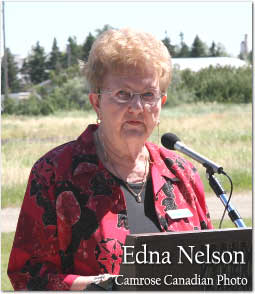
Presentation: Edna Zimmerman Nelson
October 1869- Milton visited his sisters in Michigan.
Milton left Michigan, going west to Nebraska in search land to homestead.
In 2 weeks, he went back to Freemont, N.Y.
Talk to Brother re: money left to them by their Grandfather, Henry Dackey.
November 1869- back to Nebraska. Bought 160 acres for $2/acre.
January 1870- Milton looking for more money from an Uncle Simon Snell, who lived in Mohawk Valley, N.Y. After receiving the money, he bought 160 acres of government land in Nebraska.
In 1876 he was planning to dig a basement and get married. Milton married Mary Ellen Sheeghast on December 31st, 1876.
He kept looking for land. In 1901, Milton left his wife and six children, got on the train and traveled through Minneapolis, Winnipeg, Calgary, and Edmonton and then walked to Wetaskiwin to file for a homestead.
I read in my grandmother�s diary, written in 1901 at Beatrice, Nebraska of every day projects and events:
September 30th- Fried 2 chickens and fixed lunch. Milton going on a trip tomorrow.
October 1st- She took Milton to the train. Finished threshing wheat after dinner. Arthur got load coal in the morning.
April- Arthur bought a new 18� plow for $15.50
July- Got lumber for racks- $7.45 and hardware. Then work on hayracks.
October 12, Saturday- Hattie to town, got the mail. Letters from Milton written Monday morning at Edmonton, Alberta.
Oct. 28th- Wrote to Milton and sent $150.00. Got two letters written Sunday and Monday. He is all right!
Nov.5th- Got a good long letter from Milton- he was in Edmonton a week today.
Nov.6th- Milton got home half past 9 tonight. We had gone to bed, I had gotten up and made him supper. Was glad to see him. He had lots to tell.
Nov.11th- Milton walked to town twice today. He is talking of selling the land.
Dec.23rd- Milton to town all day. Got money and paid balance of Canadian land. He paid $10.00 office fee for homestead Entry N.W. quarter � section 34 township 44- Range 18- west of 4th for himself, and S.W. quarter- section 34- township 44- Range 18- West of the 4th for Arthur, and bought 1 quarter for each of them.
Dec. 31st- Today is our 25th Wedding Anniversary. Hattie made a sweet pudding for dinner.
1902
Milton and Arthur loaded a boxcar and came by train to Wetaskiwin and I guess they hauled their stuff with horses and wagon to the homestead.
They got lumber from Wetaskiwin and built a one-room house with upstairs.
The road was a trail not squared off yet by sections.
They built fences and shelter for animals- I�m sure they had wood cut and a stone for winter.
Milton went back to Beatrice.
1903
Milton returned in the spring with his eldest daughter Hattie in a boxcar load. They worked on improving their site and home- and cutting wood.
1904
This year Milton returned with the rest of his family- Mary Ellen, Myrtle, Ivan, Hobart and Alvin 5 years old.
The house was large enough for beds for all of them. He brought 2 boxcars of stuff.
They were ready to cut brush and break land.
I know they had steam engines and big breaking plows and I know all the boys worked, so they didn�t do it all in a couple of years.
A town sprung up just � mile north- kitty corner from their land. Milton Zimmerman suggested Kelsey for the name. It was built on Moses Kelsey�s land.
1915
Milton had acquired � section across the road from home, and there is mention of the Calden Place in the diary 1915.
There were buildings coming up in town- store, station house, pool hall and elevators. The Zimmerman boys hauled sand, gravel and water and helped with the elevator. Mary Ellen cooked for 13-15 men, maybe more on rainy days.
Milton had acquired land in Minnesota and Arthur and Hobart went in 1915. They built a shack and picked rocks the first year. There were farmers there so they had neighbors. They came home early fall.
1916
May 28th An elevator burned down last night. Grain burned for several days.
Arthur went back to Minnesota in 1916. He wrote that he had bought a new Ford car- 2 seats for $480.00! After he came home he helped load cars with grain.
Jim wondering �shoveling�.
July 11th: Milton, Ivan and Mary Ellen to Edmonton fair. Hobart took us to the train.
July 13th: Myrtle, Hobart and Alvin to Edmonton fair on train.
Sold 69 hogs at 19 cents = $3070.40. Drove them to the stockyards in Kelsey- up the ramp and onto the train.
1917
Arthur back to Minnesota.
June 3rd: Mr. Anderson here to show us a car. Took us for a ride!
June 6th: Mr. Richmond came from Daysland with a new Ford car. Bought it $550.00
In July this year, Arthur�s neighbor came and asked him if he could take his car and take the neighbor on the other side to Crookston Park for a Family Picnic. Arthur was happy to oblige and show off his car. So July 22nd was the day and they went to the picnic.
Now the interesting angle! The neighbor was Clarence and Alcesta Myers and Gail and Carrie. The rest of the family picnic was Michael and Emma Kuhn, Edna, Barbara and Mary; Daniel and Martha Magsam and Lester and John Raymond and Alma and Alva Kuhn and Carrie Grove and son Clarence.
Alcesta and Michael and Martha and Alva all lived there and Carrie was visiting her brothers and sisters from Pennsylvania. Carrie had been married 10 years before and had a son Clarence. So they came just for the summer to visit.
But Carrie and Arthur met and they were married October 7th, and loaded 2 box cars the next day and went back to Bawlf Alberta and went and live with the rest of the Zimmermans at Kelsey.
How special- a man from Nebraska and a lady from Pennsylvania met in Minnesota and Moved to Canada and raised a family of 1+7+1=9!
All the land they got is still in the family.

KELSEY TRIBUTE FOOD INTERPRETATION
By Cathie Murray
Many of the pioneers that settled in the Kelsey area came from the American Midwest and Eastern Seaboard. The pioneer lunch on Saturday and the Thursday and Friday desserts reflect the foods that were popular in the early 1900�s.
The menu for the Saturday featured the following foods and their historical context was explained.
MENU
Soup: Corn Chowder
Entr�e:
Homemade Baked Beans With Boston Brown Bread
Sliced Ham�Most homesteads raised pigs and the sow could have two litters per year. Fat was rendered for use in cooking and baking; the meat was cured or smoked for longer keeping.
Steamed Green Beans With Walnuts�Vegetables were stored in root cellars, under the bed (i.e. squash) or dried.
Salad
Fresh Leaf Greens with Vinaigrette dressing along with tomato slices, cucumbers, tomato slices, carrots sticks and celery. Salads were not as we know them today. Salads were a raw vegetable with a simple dressing or combination of leftovers moistened with dressing (i.e., potatoe salad, meat salads). Our ancestors did eat plenty of raw vegetables, but unadorned. When in season there would be a plate of tomato slices or wedges of lettuce or cabbage on the table. There would be glasses of celery, carrot sticks and green onions. These were considered as �relishes.� Probably because they added relish to the meal. The vegetables would be dipped in a pile of salt on the plate.
BreadsAnadama Bread and Boston Brown Bread. These breads were typical breads made with molasses, cornmeal, and white flour of the American East Coast.
Sandwich
Egg Salad Sandwich made from homemade Anadama Bread
Desserts
Boston Cream Pie�A creation of the East Coast, pies, cakes and puddings were popular desserts as more of the population were rural & living in smaller communities. Many had their own milk cows and hens so they had the ingredients for baking (milk, cream, butter and eggs).
Apple Crisp�Ever since Johnny Appleseed planted his apple seeds across America apples have became a very popular fruit throughout the United States. What is more American than Apple pie? Also apples could be stored or dried for winter use. There were other seasonal fruits and berries, but apple recipes predominate the cookbooks of the time.

Many thanks!
To Janet Hillaby and The Camrose Canadian, for use of their photos.


View Event Photos

Home |
Kelsey History |
Kelsey Newsletter |
Community Photos
Kelsey Drama Club |
Contact Information